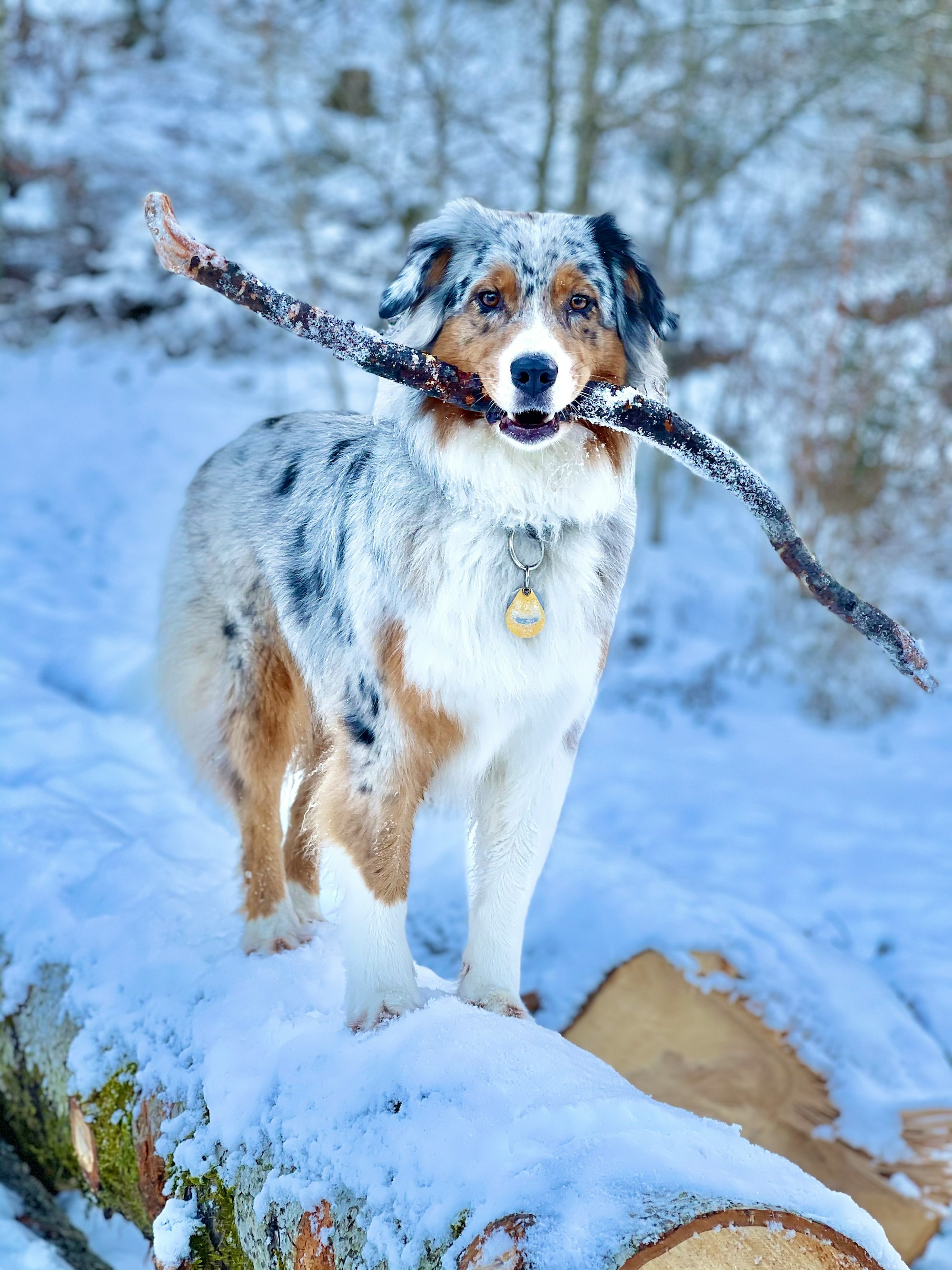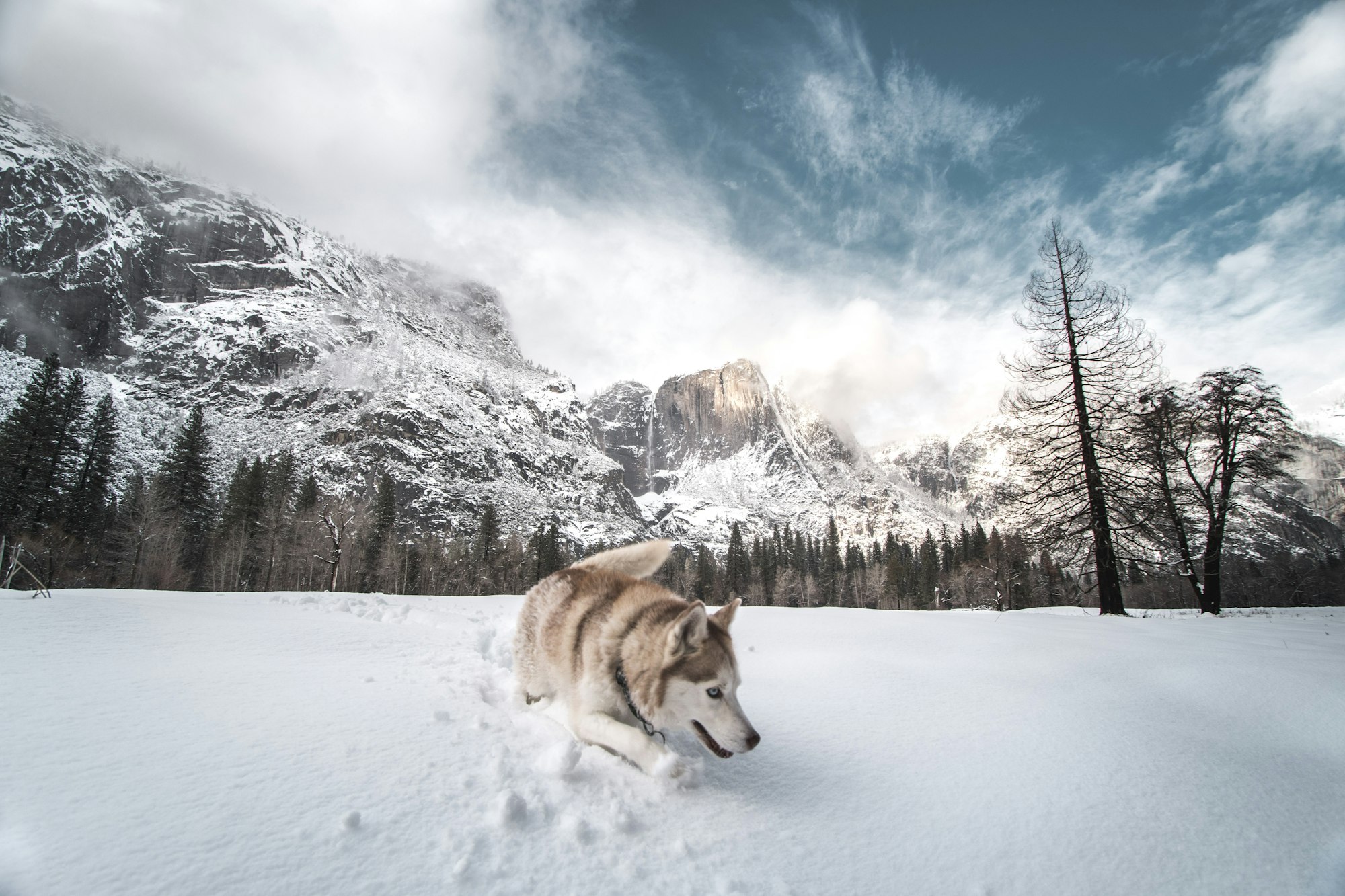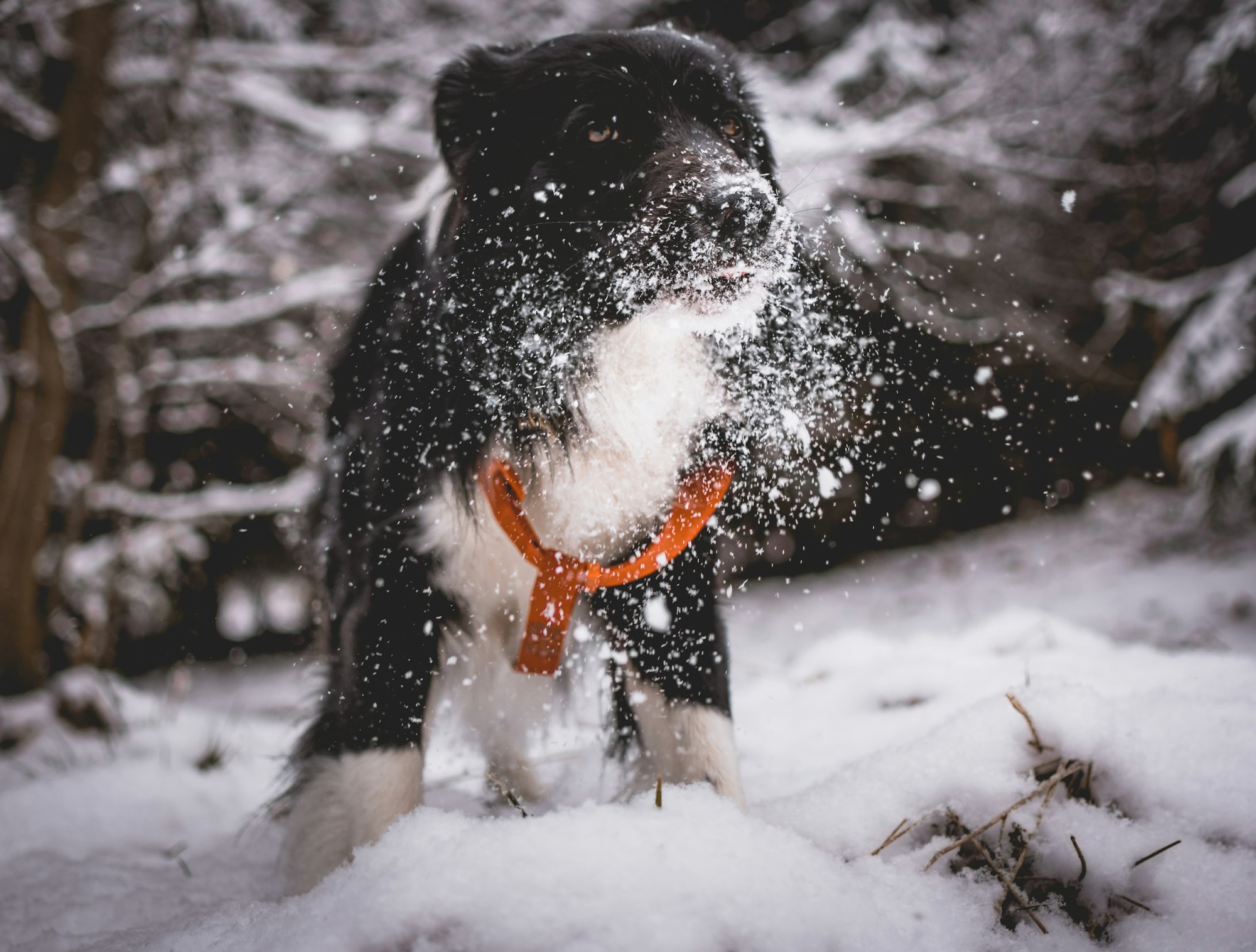Engaging in winter activities with your dog can be a rewarding and enjoyable experience for both you and your furry friend. Not only does it provide a great opportunity for physical exercise and mental stimulation, but it also helps strengthen the bond between you and your dog. These activities promote good health and weight management for your canine companion.

There are several popular winter activities that you can enjoy with your dog. Winter hiking and walking are excellent options that allow you to explore nature and enjoy the beauty of the winter landscape together. Snowshoeing is another activity that can be exciting and challenging for both you and your dog. If you're into skiing, cross-country skiing is a fantastic activity to try with your furry friend. For dogs with a lot of energy, sledding or pulling activities can provide an outlet for their natural instincts. Skijoring, which involves your dog pulling you on skis, is another thrilling winter sport to consider.
You can also have fun playing snowball fetch with your dog, making the most of the snowy environment. On those particularly cold days, there are plenty of indoor activities to keep your dog entertained and mentally stimulated. To ensure the safety and well-being of your dog during winter activities, it's essential to follow some tips. Check the weather conditions before heading out to avoid any extreme conditions.

Dress your dog appropriately in a coat or sweater to keep them warm in cold temperatures. Protect their paws by using booties or applying paw balm to prevent cracking from ice and salt. It's crucial to keep your dog hydrated and nourished during activities, so bring water and snacks for them. Finally, know your dog's limitations and avoid pushing them too hard or exposing them to conditions that are not suitable for their breed or health. By incorporating these tips and engaging in winter activities with your dog, you can create lasting memories, keep them active and happy, and strengthen the bond between you and your furry companion.
Key takeaways:
- Physical exercise and mental stimulation: Winter activities with your dog provide important physical exercise and mental stimulation, helping to keep them healthy and happy during the colder months.
- Bonding and relationship building: Engaging in winter activities with your dog helps strengthen the bond between you and your furry friend, creating a closer and more fulfilling relationship.
- Tips for safe winter activities: When participating in winter activities with your dog, remember to check weather conditions, dress them appropriately, protect their paws, keep them hydrated and nourished, and always be aware of their limitations to ensure their safety and well-being.
Benefits of Engaging in Winter Activities with Your Dog
Engaging in winter activities with your dog can bring numerous benefits that go beyond just having fun in the snow. Discover the advantages of bonding and relationship building, enhancing physical exercise and mental stimulation, and promoting good health and weight management. Whether it's romping through the snow or playing fetch in a winter wonderland, these activities offer a rewarding way to spend quality time with your furry companion while reaping the positive outcomes for both of you. Get ready to unleash the joy of winter adventures with your beloved pup!
Physical Exercise and Mental Stimulation
Engaging in winter activities with your dog provides both physical exercise and mental stimulation, benefiting both you and your furry friend. Here are some activities to consider for physical exercise and mental stimulation:
- Winter hiking and walking: Enjoy the winter scenery while giving your dog a good workout.
- Snowshoeing: Let your dog explore snowy trails alongside you for a fun adventure.
- Cross-country skiing: Teach your dog to ski alongside you, providing an extra challenge and bonding experience.
- Sledding or pulling activities: Harness your dog to a sled or cart and let them assist in the fun.
- Skijoring: Attach your dog to your own cross-country skis and let them pull you along.
- Snowball fetch: Engage your dog with a game of fetch in the snow for a mental and physical challenge.
- Indoor activities for cold days: Play hide and seek or engage in interactive toys to keep your dog mentally stimulated.
Participating in these activities will ensure that your dog stays physically active and mentally engaged.
Bonding and Relationship Building
Engaging in winter activities with your dog can naturally strengthen the bond between you and your furry friend. Here are some ways in which these activities contribute to bonding and relationship building:
- Time spent together: Participating in winter activities allows you to spend quality time with your dog, fostering a deeper connection.
- Shared experiences: Experiencing new adventures together creates shared memories and builds a sense of companionship.
- Trust and communication: Engaging in activities like sledding or skijoring requires teamwork and coordination, enhancing trust and communication between you and your dog.
- Physical touch and affection: Cuddling up after an active day outdoors helps create a stronger emotional bond through physical touch and affection.
- Understanding and empathy: Winter activities provide opportunities to observe your dog's behavior and needs, promoting a better understanding and empathy towards them.
Fact: Studies have shown that engaging in activities that promote bonding and relationship building can naturally improve overall well-being for both dogs and their owners.
Promotes Good Health and Weight Management
Engaging in winter activities with your dog not only promotes good health and weight management, but also provides fun and bonding time. Here are some ways these activities benefit your dog's well-being:
- Physical Exercise: Winter activities like hiking, snowshoeing, and skiing not only provide excellent cardiovascular workouts but also help maintain a healthy weight.
- Mental Stimulation: Exploring new scents and sights in the winter landscape engages your dog's mind, preventing boredom and promoting mental well-being.
- Weight Management: Regular exercise during winter activities not only helps prevent obesity but also maintains a healthy weight for your dog.
Fact: Regular exercise can help reduce the risk of chronic diseases, such as diabetes, and improve overall life expectancy for dogs.
Popular Winter Activities to Enjoy with Your Dog
Looking for fun ways to bond with your furry friend this winter? Look no further! Discover an array of exciting adventures you can embark on with your dog in the snowy wonderland. From invigorating winter hikes to thrilling snowball fetch games, we've got you covered. Unleash the potential of winter hiking and walking, or perhaps try your hand at skijoring for an exhilarating experience. Get ready to make unforgettable memories with your pup as we explore the world of popular winter activities for dogs.
Winter Hiking and Walking
- Embrace the joy of winter hiking and walking with your dog. It's an excellent way to relish the outdoors and ensure both you and your pet stay active during the colder months.
- Prioritize safety and enjoyment by following these steps:
- Prepare for the weather: Dress yourself and your dog in suitable layers to stay warm and protected from the elements.
- Choose a well-maintained and safe trail for winter hiking.
- Ensure your dog's safety by keeping them on a leash and preventing them from straying too far from the trail.
- Always be mindful of your dog's limitations. Take frequent breaks and be attentive to any signs of fatigue or discomfort.
- Keep your dog hydrated and nourished throughout the hike by bringing water and treats.
- Stay vigilant for potential hazards like icy patches or deep snow, and adjust your route if necessary.
- Lastly, don't forget to savor the experience. Take a moment to marvel at the beauty of nature and cherish the special bond you share with your furry companion.
Snowshoeing
is a popular winter activity that you can enjoy with your dog. Here are some steps to make the most out of your snowshoeing experience:
- Choose the right equipment: Make sure you have snowshoes suitable for your dog's size and weight. Consider getting booties to protect their paws from cold and snow.
- Check the weather conditions: Ensure that the weather is suitable for snowshoeing and that it is safe for you and your dog.
- Find dog-friendly trails: Look for trails that allow dogs and are appropriate for snowshoeing. Make sure to follow all trail rules and regulations.
- Start slow: If your dog is new to snowshoeing, start with short walks to let them get used to the snowshoes and the activity.
- Stay hydrated: Bring water for both you and your dog to stay hydrated during the activity. Remember that dogs can get dehydrated in the cold too.
- Take breaks: Allow your dog to rest and take breaks as needed. Pay attention to signs of fatigue or discomfort.
- Enjoy and bond: Snowshoeing is a great way to bond with your dog while getting exercise and enjoying the winter scenery.
By following these steps, you can have a safe and enjoyable snowshoeing experience with your furry friend.

Cross-Country Skiing
Cross-Country Skiing is a popular winter activity that you can enjoy with your dog. It provides great exercise for both you and your furry friend. Here is a highlighting some key aspects of Cross-Country Skiing with your dog:
| Aspects | Details |
|---|---|
| Physical Benefits | Builds endurance and helps maintain weight |
| Mental Stimulation | Offers a change of scenery and mental focus |
| Safety Considerations | Ensure proper gear and leash control |
| Preparation and Training | Train your dog to stay on the designated path |
| Hydration and Nutrition | Bring water and treats for breaks |
Fact: Did you know that Cross-Country Skiing can burn up to 700 calories per hour for humans? It's a fantastic way to stay active and enjoy the winter season with your canine companion.
Sledding or Pulling Activities
Sledding or pulling activities can be a fun and engaging winter activity to enjoy with your dog. Here are some options to consider:
- Dog Sledding: Experience the thrill of mushing with your furry friend by participating in sledding with dogs. This activity involves your dog pulling a sled while you guide them.
- Carting: If you don't have access to snow, carting is a great alternative. Your dog can engage in pulling activities by pulling a cart or wagon on trails or in open areas.
- Weight Pulling: This challenging activity involves your dog engaging in pulling activities by pulling a weighted sled or cart. It helps build strength and endurance in your dog's muscles.
- Snowball Fetch: Turn a traditional game of fetch into a winter adventure by incorporating sledding and pulling activities. Throw snowballs for your dog to retrieve and enjoy the fun together.
By engaging in these sledding or pulling activities, you can strengthen your bond with your dog while enjoying the winter season. Just make sure to choose activities that are suitable for your dog's breed, size, and fitness level.
Skijoring
Skijoring is an exciting winter activity that involves being pulled on skis by your dog. It combines the thrill of skiing with the companionship of your furry friend. Here are some key points to consider when engaging in skijoring:
- Equipment: Invest in proper skijoring gear, including a waist belt, towline, and a harness for your dog.
- Dog Training: Ensure that your dog is properly trained and comfortable with pulling and following commands.
- Trail Conditions: Choose well-groomed and even terrain for a smooth skijoring experience.
- Start Slow: Begin with short sessions to build up your dog's endurance and prevent fatigue or injury.
- Safety Measures: Always wear appropriate safety gear, such as helmets, and be mindful of potential hazards.
- Hydration and Nutrition: Keep your dog hydrated and provide adequate nutrition before and after skijoring.
- Fun and Bonding: Skijoring offers a unique opportunity to strengthen the bond between you and your dog while enjoying the outdoors.
Snowball Fetch
Playing snowball fetch with your dog is an enjoyable way to embrace the winter season and keep your furry friend entertained. Here are some helpful tips for a fantastic snowball fetch experience:
- Find an open area with plenty of space to indulge in snowball fetch.
- Create small and soft snowballs that are easy for your dog to grab.
- Toss the snowballs at a short distance, allowing your dog to chase and retrieve them.
- Ensure that you use fresh, clean snow to avoid any dirt or debris.
- Always keep an eye on your dog's activity level and take breaks if they appear tired.
Fact: Dogs possess a natural layer of insulation in their paws that safeguards them from the cold.
Indoor Activities for Cold Days
When the weather outside is too cold for outdoor activities, there are plenty of indoor options to keep your dog entertained and active. Consider the following
- Hide and Seek: Hide treats or toys throughout the house for your dog to find.
- Indoor Fetch: Play fetch in a hallway or large room using a soft toy or ball.
- Obstacle Course: Set up a simple obstacle course using cushions, tunnels, and other household items.
- Tug-of-War: Engage in a fun and interactive game of tug-of-war with your dog.
- Brain Games: Stimulate your dog's mind with puzzle toys or treat-dispensing games.
True story: On a freezing winter day, I set up Indoor Activities for Cold Days in the form of an indoor obstacle course for my dog. He had a blast navigating through tunnels, jumping over cushions, and weaving through makeshift hurdles. It was a great way to keep him entertained and active while staying warm indoors.
Tips for Safely Enjoying Winter Activities with Your Dog
When it comes to winter activities with your furry friend, keeping them safe and comfortable is a top priority. In this section, we'll explore some essential tips to ensure you and your happy dog enjoy winter adventures to the fullest. From checking weather conditions to dressing your dog appropriately, protecting their paws, and ensuring they stay hydrated and nourished, we'll cover everything you need to know. Remember, understanding your dog's limitations is key to keeping them happy and healthy during wintertime escapades.
Checking Weather Conditions
- To ensure your dog's safety during winter activities, it is vital to check weather conditions beforehand. By checking the temperature, you can determine if it is suitable for outdoor activities or if it is better to engage in indoor activities instead. Make sure the temperature is not too extreme for your dog as they are susceptible to cold and can suffer from hypothermia or frostbite if exposed to very low temperatures.
- In addition to checking the temperature, it is important to check for storms or extreme weather. If there are storms, blizzards, or other severe weather conditions, it is best to avoid going out with your dog as it could pose a risk to both of you.
- Another factor to consider is the wind chill. Pay attention to the wind chill factor as it can make the temperature feel even colder. To protect your dog from strong winds, dress them appropriately.
- Lastly, assess the footing before allowing your dog to walk or engage in activities. If the ground is icy or covered in snow, it can be slippery, increasing the risk of accidents. Ensure that the conditions are safe for your dog.
Back in 1925, the "Great Race of Mercy" showcased the incredible bravery of a sled dog team. These dogs delivered lifesaving medical supplies to the remote town of Nome, Alaska, enduring treacherous winter conditions with temperatures as low as -40°F. Their heroic journey, known as the Iditarod Trail Sled Dog Race, serves as a testament to the strength and resilience of our canine companions in harsh weather.
Dressing Your Dog Appropriately
When dressing your dog appropriately for winter activities, it's important to consider their comfort and safety. Here are some tips to dress your dog in a way that is suitable:

- Choose the right size: Make sure the clothing fits your dog properly, allowing them to move comfortably.
- Layer up: Use a combination of insulating and waterproof layers to keep your dog warm and dry.
- Protect extremities: Use booties to safeguard their paws from cold and ice, and consider a hat or snood to cover their ears.
- Consider their breed: Dogs with short hair or low body fat may need additional insulation, such as a coat or sweater.
Protecting Your Dog's Paws
Protecting Your Dog's Paws during winter activities is of utmost importance to ensure their safety and comfort. Here are some crucial steps to take to accomplish this:
- Regularly inspect your furry friend's paws for any signs of injury, including cuts or cracks.
- Prevent the buildup of snow or ice by trimming excess hair between their paw pads.
- Apply a specialized paw protectant or balm to establish a protective barrier against the frigid surfaces.
- Enhance insulation and shield their paws from potential harm caused by salt or chemical ice melt by considering the use of booties.
- After each outdoor session, make sure to thoroughly wash and dry their paws to eliminate any debris or irritants.
- Trim your dog's nails appropriately to prevent them from getting stuck or causing discomfort on icy surfaces.
Keeping Hydrated and Nourished
- Ensuring your dog stays hydrated and nourished during winter activities is vital for their well-being. Here are some essential tips to keep them healthy and happy:
- Remember to bring an ample supply of water for yourself and your furry companion. Staying hydrated is crucial in cold weather.
- Carry nutritious snacks that are packed with energy, such as freeze-dried meats or homemade treats, to keep your dog fueled and energized during the activities.
- To prevent the water from freezing, use insulated bottles or bring a thermos filled with warm water. This will allow your dog to drink whenever they need it.
| In the 1925 serum run to Nome, Alaska, the town faced a diphtheria outbreak that posed a serious threat. |
|---|
| In order to deliver life-saving serum, sled dog teams like Balto and Togo braved blizzard conditions. |
| Throughout this treacherous journey, these heroic dogs were kept hydrated and nourished, emphasizing the significance of proper care during winter activities. |
Knowing Your Dog's Limitations
Knowing Your Dog's Limitations is essential when participating in winter activities with your furry friend. It's crucial to understand that each dog has its own physical abilities, endurance, and tolerance to cold temperatures. Before engaging in any winter activity, it is important to take into account your dog's breed, age, health condition, and fitness level. Keep in mind that some dogs may not be capable of handling long hikes in snowy conditions, while others may easily become exhausted or risk developing hypothermia. Always pay close attention to your dog's behavior, provide them with regular breaks, and ensure they are comfortable and protected from the cold. Remember, the safety of your dog should always be a top priority when enjoying winter activities together.
Fact: Dogs have a higher tolerance for colder temperatures than humans due to their fur coats and their ability to regulate body temperature more efficiently. It is worth noting that each dog is unique and may have different tolerances to cold weather.

Frequently Asked Questions
What are the benefits of winter activities for dogs?
Winter activities with dogs are beneficial for their physical and mental health. Being active outdoors stimulates the mind and body, boosts immunity, and keeps digestion regular. Regular time outdoors has benefits for both physical and psychological human wellbeing. Outdoor activities provide daily exercise for dogs and introduce new scents, sounds, and sights for enrichment and communication.
What are some winter activities suitable for dogs?
There are several winter activities that dogs can enjoy. Some popular options include hiking, walking or running in snowy weather, dog skiing or skijoring, nose work in snowy environments, and even small dog breeds can benefit from outdoor activities in winter. Playing fetch in the snow, creating a snow maze, visiting indoor dog parks or doggie daycares, and engaging in indoor training sessions are also great options to keep your dog happy and active during winter.
How can I ensure the safety of my dog during winter activities?
To ensure the safety of your dog during winter activities, it is important to review winter safety tips for pets. Some basic tips include limiting their time outdoors in the cold weather, dressing them in booties and/or a sweater to keep them warm, providing fresh water to prevent them from eating snow that may contain harmful substances, cleaning their paws after play to remove de-icer residue, and being aware that older dogs or those with arthritis may be less tolerant to cold weather. If you have any concerns about winter safety for your pet, contact your primary veterinarian.
What precautions should I take when walking my dog in snowy weather?
When walking your dog in snowy weather, it is still possible to enjoy a nice walk. However, consider taking shorter walks more frequently to avoid prolonged exposure to the cold. Watch for signs of coldness in your dog, such as shivering or lifting their paws off the ground, and end the walk if necessary. It is also important to avoid areas with ice to prevent slipping. Make sure your dog is dressed in snazzy snow boots to protect their paws from freezing temperatures.
How can I keep my dog entertained indoors during the winter months?
During the winter months, when it may not be possible to spend as much time outdoors, there are various ways to keep your dog entertained indoors. Engaging in indoor training sessions with your dog to teach new tricks or commands can keep them mentally challenged. Treat dispensing toys, such as the Buster Cube or Outward Hound Fun Feeder, can provide both mental and physical exercise. Cozy canine cuddles and a warm, comfortable bed are also important for your dog's well-being.
What are some signs that my dog may be experiencing cabin fever?
During the winter months, when dogs spend more time indoors, they may experience cabin fever. Signs that your dog may be experiencing cabin fever include increased restlessness, chewing or scratching furniture, excessive barking, or displaying other unpleasant behavior issues. It is important to provide mental and physical stimulation for your dog through winter activities to avoid boredom and unpleasant behavior problems.




